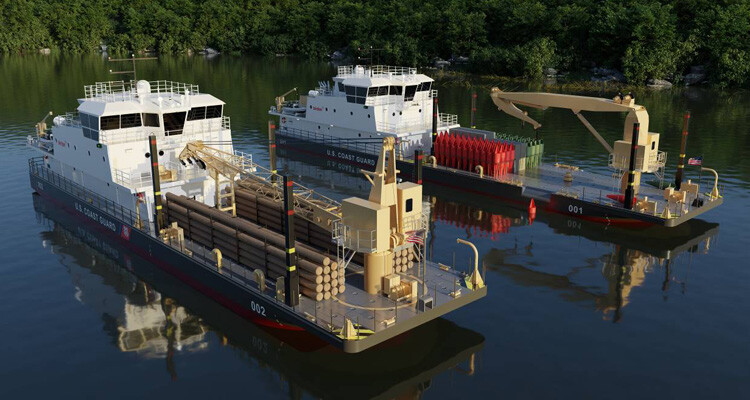Every spring, the commandant of the Coast Guard and the heads of all other federal agencies appear before Congressional committees to explain how the administration wants to spend taxpayer dollars on their programs.
Sometimes these agency leaders get a mix of praise and criticism for their work and spending plans, while also fielding questions that touch on parochial, regional, and national issues that interest lawmakers. Sometimes the responses are easy and straightforward. Other times the information that a lawmaker seeks gets sidetracked by vague, incomplete answers.
This was the case recently with Coast Guard Commandant Linda Fagan when she was asked at a House Transportation and Infrastructure subcommittee budget hearing for an update on plans to build a fleet of newly designed and named waterways commerce cutters (WCC). The program would provide 30 replacements for the service’s 35 aging river buoy tenders, inland construction tenders and inland buoy tenders.
Subcommittee chair Rep. Daniel Webster, R-Fla., asked the admiral if the program is on track to have the first new cutter operational by 2025, as has previously been projected.
Fagan avoided a direct answer, saying instead that the Biden administration’s fiscal year 2024 budget includes $98 million for two WCC vessels, and for a WCC home port.
She went on to say how important the cutters are to the nation’s “economic security,” and how important the inland waterways are in facilitating maritime commerce. “So, getting them in operation is indeed a priority,” she said, without providing any further details on a timetable, but adding that these vessels “are not particularly complicated cutters and should come into operation fairly quickly.” The hearing then moved on.
Replacing the existing fleet of waterways tender fleet is important to the inland barge industry, as the cutters keep river traffic moving smoothly and safely by maintaining more than 28,200 marine aids to navigation along 12,000 miles of inland rivers, intracoastal waterways and harbors through which 630 million tons of cargo move each year. In addition, this fleet performs search and rescue, marine safety missions, marine environmental protection and ports, waterways, and coastal security.
The average age of the existing fleet of 35 vessels is 57.
In October, the Coast Guard awarded a contract to Birdon America Inc., Denver, to build up to 16 river buoy tenders, which set, relocate, and recover buoys to mark navigable channels and maintain fixed aids, and 11 inland construction tenders, which build, repair, and maintain fixed navigation within inland waterways. Total cost is about $1.2 billion. The inland buoy tenders, which service short-range aids located in shallow or otherwise restricted coastal and inland waterways, would be under another contract.
In the fiscal year 2024 budget request, the Coast Guard said that besides the fleet’s age, there are other serious problems with the vessels: hazardous materials from the use of asbestos and lead paint, outdated technology, vessel designs that threaten crew safety, high maintenance costs, non-compliance with environmental rules and the lack of space to allow for mixed gender crews.
In a similar exchange with Rep. John Garamendi, D-Calif., Fagan was criticized for not being forthcoming on a timetable and problems in building a new polar icebreaker. He interrupted her response suggesting that she should “put the happy talk aside. This is not going well,” referring to the first contractor that went “belly up,” and design problems with the new contractor. Assurances from Fagan that these problems were being addressed, and that this is a highly complex vessel to build, didn’t satisfy the congressman, who pressed for specific details on when construction would start. “We’ve been at this for a very long time, and the inability of the Coast Guard to get this started is a major national security problem.”
Lawmakers also expressed concern about the Coast Guard’s continued recruiting challenges, budget shortfalls in Biden’s spending plan that could jeopardize readiness and certain missions, and whether the Coast Guard is sufficiently examining the possible impacts of offshore wind energy projects.
“The Coast Guard continues to be spread thin,” said Webster, the subcommittee chairman. “While the president’s budget includes an increase for operations and support programs, the procurement, construction, and improvements account, which pays for new vessels, aircraft, IT and shoreside infrastructure investments, would be funded at less than half of the level Congress authorized last year. The committee is deeply concerned about what that would mean for future mission capability.”
On recruiting, Webster said that the Coast Guard’s workforce is expected to fall 4,800 members short of its hiring goals.
Fagan and Master Chief Heath B. Jones, chief petty officer, acknowledged significant recruiting problems. Fagan said it was her “highest priority to modernize our talent management system, which has not significantly changed in the last 75 years.” She also said the budget would provide military and civilian pay and benefit increases and bolster medical services, especially in mental health, training and recruiting initiatives.
Jones said that the Coast Guard is casting a wide recruiting net, asking members to talk to others about the missions of the Coast Guard and the opportunities offered, opening 10 new recruiting offices, expanding Junior ROTC programs, and targeting different groups, including gaming communities.
Jones also told the subcommittee that Coast Guard members are very concerned about access to affordable housing, health care and childcare.





